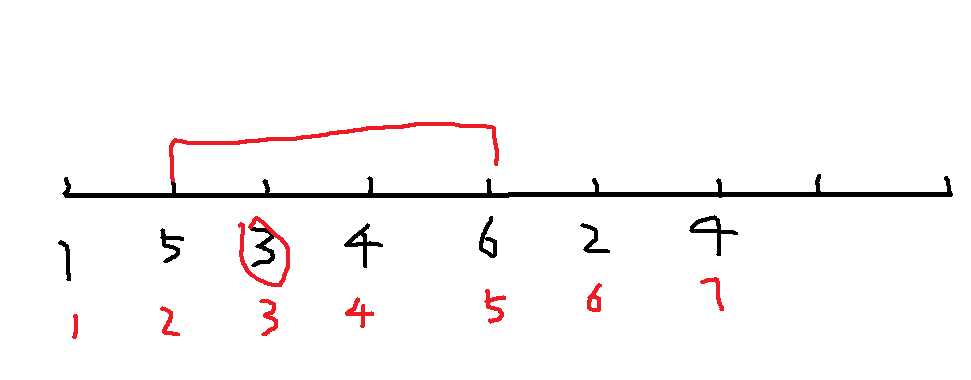The Preliminary Contest for ICPC China Nanchang National Invitational I题
Posted cglongge
tags:
篇首语:本文由小常识网(cha138.com)小编为大家整理,主要介绍了The Preliminary Contest for ICPC China Nanchang National Invitational I题相关的知识,希望对你有一定的参考价值。
Alice has a magic array. She suggests that the value of a interval is equal to the sum of the values in the interval, multiplied by the smallest value in the interval.
Now she is planning to find the max value of the intervals in her array. Can you help her?
Input
First line contains an integer n(1 le n le 5 imes 10 ^5n(1≤n≤5×105).
Second line contains nn integers represent the array a (-10^5 le a_i le 10^5)a(−105≤ai?≤105).
Output
One line contains an integer represent the answer of the array.
样例输入
5 1 2 3 4 5
样例输出
36
题意:给你一个长度为n的序列,让你找一段区间使得该段 区间和 和 它的区间最小值 乘积最大,并输出最大值。
思路:因为我们不知道当最小值是多少时 以它为最小值的区间 的和 与 它的乘积最大,所以我们只能枚举每个位置,以每个位置为最小值,求出以它为最小值的最大值
当我们以当前位置的值作为最小值时,我们怎么求出以它为最小值的最大区间和呢
首先,我们要知道以当前值为区间最小值时,它可能的区间范围

以上图为例 ,当我们以第三个位置的值为最小值时,它的区间范围为(2,5)
我们可以在区间(2,5)内找到一段区间和最大的区间(一定要包含第三号位置),就找到了以第三个位置为最小值的题目要找的最大值。
找这段和最大的区间时我们可以用前缀和建线段树来求出
当当前位置值为正数时,我们从当前位置的左边的区间找出最小的前缀和,从当前位置的右边区间找出最大的前缀和,那么,用右边找到的值减去左边的值就是我们满足我们要求的最大的区间和
(这样用右边找到的前缀和减去左边找到的前缀和不就是在中间我们要找的包含当前位置的区间最大和吗,负数的时候相反)
代码:
#include<cstdio> #include<algorithm> #include<stack> #define ll long long using namespace std; struct point{ ll a;//值 ll x;//位置 }s[500010]; stack<point> st; struct{ ll l,r;//记录以当前位置为最小值区可以取区间的范围 }bd[500010]; ll sum[500010];//前缀和 struct{ ll mx,mn;//记录前缀和的最大值和最小值 }tree[2000010]; void build(ll l,ll r,ll k){ if(l==r){ tree[k].mn=tree[k].mx=sum[l]; return ; } ll mid=(l+r)>>1; build(l,mid,k*2); build(mid+1,r,k*2+1); tree[k].mx=max(tree[k*2].mx,tree[k*2+1].mx); tree[k].mn=min(tree[k*2].mn,tree[k*2+1].mn); return ; } ll query1(ll l,ll r,ll k,ll L,ll R){//找最大值 //printf("WW%d %d %d %d ",l,r,L,R); if(l>=L&&r<=R){ return tree[k].mx; } ll a,b; a=-1e18; b=-1e18; ll mid=(l+r)>>1; if(L<=mid) a=query1(l,mid,k*2,L,R); if(R>mid) b=query1(mid+1,r,k*2+1,L,R); return max(a,b); } ll query2(ll l,ll r,ll k,ll L,ll R){//找最小值 if(l>=L&&r<=R){ return tree[k].mn; } //printf("EE%d %d %d %d ",l,r,L,R); ll a,b; a=1e18; b=1e18; ll mid=(l+r)>>1; if(L<=mid) a=query2(l,mid,k*2,L,R); if(R>mid) b=query2(mid+1,r,k*2+1,L,R); return min(a,b); } int main(){ ll n; scanf("%lld",&n); sum[0]=0; for(ll i=1;i<=n;i++){ scanf("%lld",&s[i].a); s[i].x=i; sum[i]=sum[i-1]+s[i].a; } for(ll i=1;i<=n;i++){//单调栈求范围 if(st.empty()){//如果当前栈为空,当前要放入位置的左极限位置就是自己的位置 bd[s[i].x].l=i; st.push(s[i]); } else{ point tp=st.top(); if(tp.a==s[i].a){//如果当前位置的值与栈顶的值一样,那么当前要放入位置的左极限就和栈顶位置的左极限相同 bd[s[i].x].l=bd[tp.x].l; st.push(s[i]); } else if(tp.a<s[i].a){//如果当前放入位置的值大于栈顶位置的值,那么当前放入位置的左极限位置就是自己的位置 bd[s[i].x].l=i; st.push(s[i]); } else{//如果当前放入位置的值小于栈顶位置的值 st.pop(); ll r=tp.x; ll l=bd[tp.x].l; bd[tp.x].r=r;//栈顶位置的右极限就是当前栈顶位置的位置 if(!st.empty()) tp=st.top(); while(!st.empty()&&tp.a>s[i].a){//如果下一个栈顶位置的值还是大于当前位置 st.pop(); bd[tp.x].r=r;//后面的栈顶可以到的右极限都和第一次栈顶位置的右极限相同,因为栈是从小到上递增的 l=bd[tp.x].l;//更新要放入的当前位置可以到的左极限 if(!st.empty()) tp=st.top(); } bd[s[i].x].l=l; st.push(s[i]); } } } if(!st.empty()){//更新 point tp=st.top(); ll r=tp.x; while(!st.empty()){ tp=st.top(); st.pop(); bd[tp.x].r=r; } } // for(ll i=1;i<=n;i++){ // printf("%d %d %d ",i,bd[i].l,bd[i].r); // } build(0,n,1); ll ans=-1e18; // printf("OK"); for(ll i=1;i<=n;i++){ ll r1,l1; if(s[i].a>0){ r1=query1(0,n,1,s[i].x,bd[s[i].x].r); l1=query2(0,n,1,bd[s[i].x].l-1,s[i].x-1); //printf("%lld %lld ",l1,r1); ans=max((r1-l1)*s[i].a,ans); } else if(s[i].a<0){ r1=query2(0,n,1,s[i].x,bd[s[i].x].r); l1=query1(0,n,1,bd[s[i].x].l-1,s[i].x-1); //printf("%lld %lld ",l1,r1); ans=max((r1-l1)*s[i].a,ans); } else ans=max(0LL,ans); } printf("%lld ",ans); }
以上是关于The Preliminary Contest for ICPC China Nanchang National Invitational I题的主要内容,如果未能解决你的问题,请参考以下文章